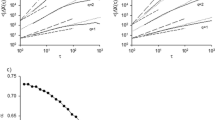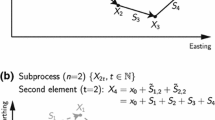Abstract
It is difficult to watch wild animals while they move, so often biologists analyse characteristics of animal movement paths. One common path characteristic used is tortuousity, measured using the fractal dimension (D). The typical method for estimating fractal D, the divider method, is biased and imprecise. The bias occurs because the path length is truncated. I present a method for minimising the truncation error. The imprecision occurs because sometimes the divider steps land inside the bends of curves, and sometimes they miss the curves. I present three methods for minimising this variation and test the methods with simulated correlated random walks. The traditional divider method significantly overestimates fractal D when paths are short and the range of spatial scales is narrow. The best method to overcome these problems consists of walking the dividers forwards and backwards along the path, and then estimating the path length remaining at the end of the last divider step.
Similar content being viewed by others
References
Benhamou, S. (1989). An olfactory orientation model for mammals' movements in their home ranges. Journal of Theoretical Biology 139: 379–388.
Benhamou, S. (1990). An analysis of movements of the wood mouse Apodemus sylvaticus in its home range. Behavioural Processes 22: 235–250.
Boone, R.B. and M.L. Hunter (1996). Using diffusion-models to simulate the effects of land-use on grizzly bear dispersal in the Rocky-Mountains. Landscape Ecology 11: 51–64.
Boonstra, R. and I.T.M. Craine (1986). Natal nest location and small mammal tracking with a spool and line technique. Canadian Journal of Zoology 64: 1034–1036.
Cain, M.L. (1985). Random search by herbivorous insects: A simulation model. Ecology 66: 876–888.
Fauvergue, X., P. Fouillet, A.L.M. Mesquita and M. Bouletreau (1998). Male orientation to trail sex pheromones in parasitoid wasps: Does the spatial distribution of virgin females matter? Journal of Insect Physiology 44: 667–675.
Fritz, H., S. Said and H. Weimerskirch (2003). Scale-dependent hierarchical adjustments of movement patterns in a long-range foraging seabird. Proceedings of the Royal Society of London Series B 270: 1143–1148.
Krummer, J.R., R.H. Gardner, G. Sugihara, R.V. O'Neill and P.R. Coleman (1987). Landscape patterns in a disturbed environment. Oikos 48: 321–324.
Mandelbrot, B. (1967). How long is the coast of Britain? Statistical self-similarity and fractional dimension. Science 156: 636–638.
Mårell, A., J.P. Ball and A. Hofgaard (2002). Foraging and movement paths of female reindeer: Insights from fractal analysis, correlated random walks, and Lévy flights. Canadian Journal of Zoology 80: 854–865.
Merritt, J.F. (1981). Clethrionomys gapperi. Mammal Species 146: 1–9.
Milne, B.T. (1997). Applications of fractal geometry in wildlife biology. In: Bissonette, J.A. (Ed). Wildlife and Landscape Ecology. Effects of Pattern and Scale. Springer, New York. pp. 32–69.
Nams, V.O. (1996). The VFractal: A new estimator for fractal dimension of animal movement paths. Landscape Ecology 11: 289–297.
Nams, V.O. (2005). Using animal movement paths to measure response to spatial scale. Oecologia 143: 179–188.
Nams, V.O. and M. Bourgeois (2004). Fractal dimension measures habitat use at different spatial scales: an example with marten. Canadian Journal of Zoology 82: 1738–1747.
Phillips, M.L., W.R. Clark, S.M. Nusser, M.A. Sovada and R.J. Greenwood (2004). Analysis of predator movement in prairie landscapes with contrasting grassland composition. Journal of Mammalogy 85: 187–195.
Turchin, P. (1996). Fractal analyses of animal movement—a critique. Ecology 77: 2086–2090.
Wallin, H. (1991). Movement patterns and foraging tactics of a caterpillar hunter inhabiting alfalfa fields. Functional Ecology 5: 740–749.
With, K.A. (1994). Ontogenetic shifts in how grasshoppers interact with landscape structure: An analysis of movement patterns. Functional Ecology 8: 477–485.
With, K.A., D.M. Pavuk, J.L. Worchuck, R.K. Oates and J.L. Fisher (2002). Threshold effects of landscape structure on biological control in agroecosystems. Ecological Applications 12: 52–65.
Zollner, P.A. and S.L. Lima (1999). Search strategies for landscape-level interpatch movements. Ecology 80: 1019–1030.
Author information
Authors and Affiliations
Corresponding author
Rights and permissions
About this article
Cite this article
Nams, V.O. Improving Accuracy and Precision in Estimating Fractal Dimension of Animal movement paths. Acta Biotheor 54, 1–11 (2006). https://doi.org/10.1007/s10441-006-5954-8
Received:
Accepted:
Issue Date:
DOI: https://doi.org/10.1007/s10441-006-5954-8




